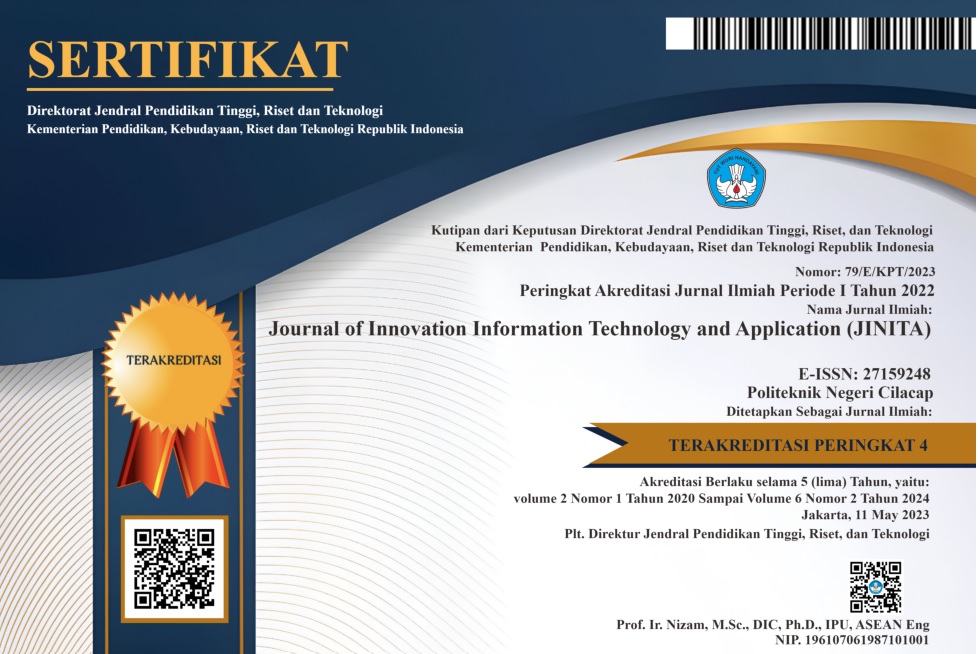Pengembangan Metode Login Two Factor Authentication (2FA) untuk Keamanan Sistem Informasi Akademik
 Abstract views: 865
,
Abstract views: 865
,
 PDF downloads: 1056
PDF downloads: 1056
Abstract
Transformasi secara massive di era society 5.0 memberikan banyak perubahan terhadap pola hidup umat manusia, salah satunya pada ranah pendidikan. Banyak organisasi pendidikan berlomba-lomba untuk meningkatkan kualitas pendidikan terutama pada kualitas pelayanan akademik. Peralihan dari model pelayanan akademik konvensional menjadi sebuah model sistem informasi akademik membuat perubahan baru pada ranah organisasi pendidikan. Namun, isu-isu muncul saat penerapan sistem informasi akademik terkait keamanan sistem informasi yang disebabkan beberapa faktor diantaranya kelalaian user terhadap pengamanan password login. Isu kelalaian user menjadi motivasi pada tulisan ini untuk menjawab bagaimana mengatasi kelemahan tersebut. Metode two-factor authentication (2FA) verifikasi dengan kolaborasi aplikasi Telegram diterapkan agar dapat membantu meminimalisir kelemahan pada keamanan sistem informasi akademik. Metode ini menjadi gagasan awal untuk pengamanan sistem informasi akademik agar tidak dengan mudah orang yang tidak bertanggung jawab dapat login ke sistem informasi akademik.
References
M. K. Sharma and M. J. Nene, “Two‐factor authentication using biometric based quantum operations,” Secur. Priv., vol. 3, no. 3, 2020, doi: 10.1002/spy2.102.
Thanasis Petsas, Giorgos Tsirantonakis, Elias Athanasopoulos, and Sotiris Ioannidis. 2015. Two-factor authentication: is the world ready? quantifying 2FA adoption. In Proceedings of the Eighth European Workshop on System Security (EuroSec '15). Association for Computing Machinery, New York, NY, USA, Article 4, 1–7. https://doi.org/10.1145/2751323.2751327.
C. Z. Acemyan, P. Kortum, J. Xiong, and D. S. Wallach, “2FA might be secure, but it’s not usable: A summative usability assessment of Google’s two-factor authentication (2FA) methods,” Proc. Hum. Factors Ergon. Soc., vol. 2, pp. 1141–1145, 2018, doi: 10.1177/1541931218621262.
D. Wang, Q. Gu, H. Cheng, and P. Wang, “The request for better measurement: A comparative evaluation of two-factor authentication schemes,” ASIA CCS 2016 - Proc. 11th ACM Asia Conf. Comput. Commun. Secur., no. May, pp. 475–486, 2016, doi: 10.1145/2897845.2897916.
P. Gope and B. Sikdar, “Lightweight and Privacy-Preserving Two-Factor Authentication Scheme for IoT Devices,” IEEE Internet Things J., vol. 6, no. 1, pp. 580–589, 2019, doi: 10.1109/JIOT.2018.2846299.
J. Zhang, X. Tan, X. Wang, A. Yan, and Z. Qin, “T2FA: Transparent Two-Factor Authentication,” IEEE Access, vol. 6, pp. 32677–32686, 2018, doi: 10.1109/ACCESS.2018.2844548.
N. Karapanos et al., “Sound-Proof : Usable Two-Factor Authentication Based on Ambient Sound This paper is included in the Proceedings of the,” Usenix Secur., 2015.
R. S. Pressman and B. R. Maxim, Software Engineering A PRACTITIONER’S APPROACH. McGraw-Hill, 2020.
D. E. Kurniawan, M. Iqbal, J. Friadi, F. Hidayat, and R. D. Permatasari, “Login Security Using One Time Password (OTP) Application with Encryption Algorithm Performance,” J. Phys. Conf. Ser., vol. 1783, no. 1, 2021, doi: 10.1088/1742-6596/1783/1/012041.
H. Khalid, S. J. Hashim, S. M. S. Ahmad, F. Hashim, and M. A. Chaudary, “New and Simple Offline Authentication Approach using Time-based One-time Password with Biometric for Car Sharing Vehicles,” 2020 IEEE Asia-Pacific Conf. Comput. Sci. Data Eng. CSDE 2020, no. April 2021, 2020, doi: 10.1109/CSDE50874.2020.9411569.
Copyright (c) 2022 Journal of Innovation Information Technology and Application (JINITA)

This work is licensed under a Creative Commons Attribution 4.0 International License.
Authors who publish with this journal agree to the following terms:
- Authors retain copyright and grant the journal right of first publication with the work simultaneously licensed under a Creative Commons Attribution License that allows others to share the work with an acknowledgement of the work's authorship and initial publication in this journal.
- Authors are able to enter into separate, additional contractual arrangements for the non-exclusive distribution of the journal's published version of the work (e.g., post it to an institutional repository or publish it in a book), with an acknowledgement of its initial publication in this journal.
- Authors are permitted and encouraged to post their work online (e.g., in institutional repositories or on their website) prior to and during the submission process, as it can lead to productive exchanges, as well as earlier and greater citation of published work (See The Effect of Open Access).
















